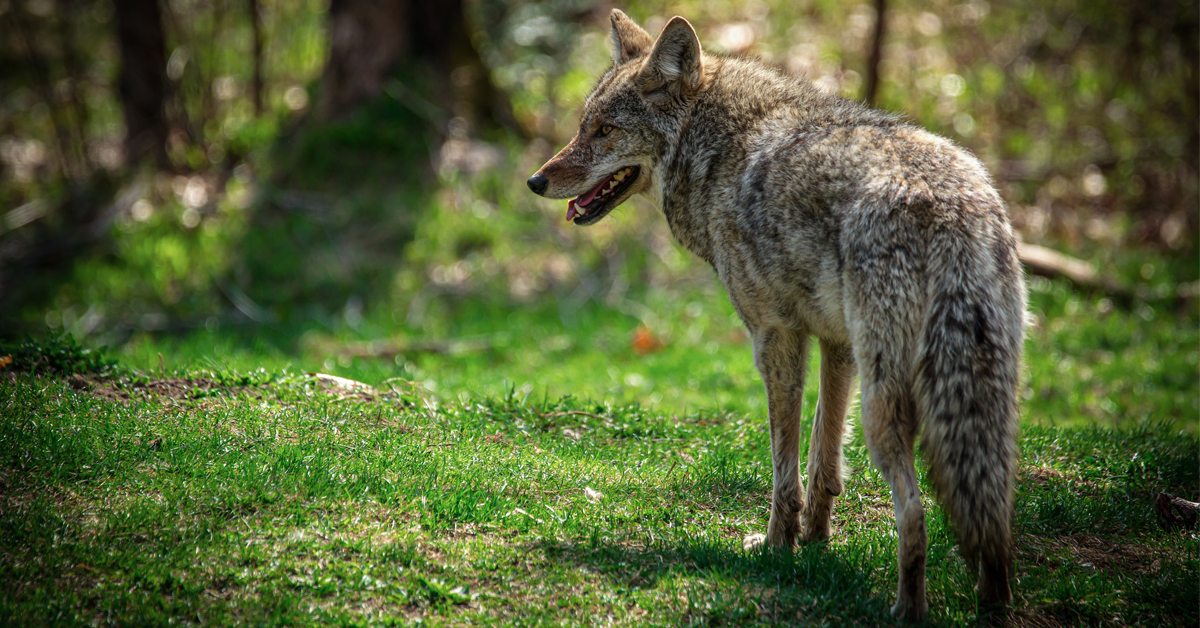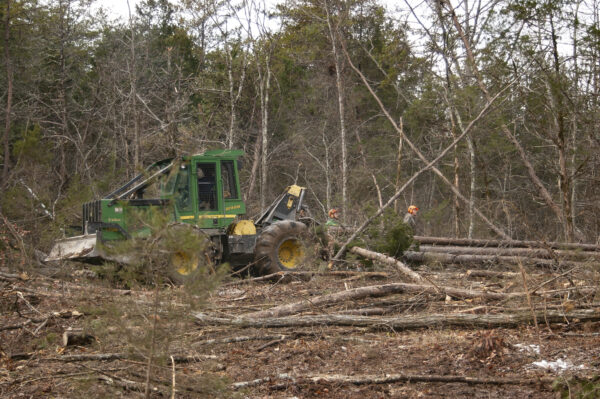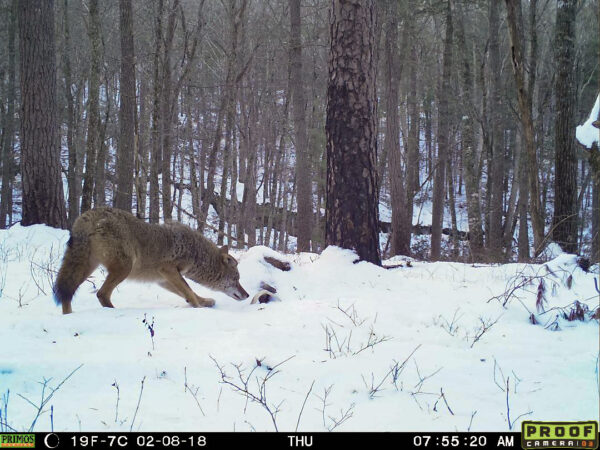
By Bruce Ingram for Whitetail Times
A hot topic among deer hunters is the ever-increasing coyote population. Learning more about the coyote and how they affect local deer herds is a demanding challenge!
As an outdoor writer, I cannot present a hunting seminar without someone stating that coyotes have decimated the deer numbers in his county. For that matter, I can’t present a fishing seminar without someone maintaining that the muskies have eaten all the smallmouth bass in his home river. This story won’t delve into the musky and black bass dynamic, but it will explore what the science says about the effect of coyotes on the Old Dominion’s whitetails.
Before the science, here’s a personal anecdote regarding the deer and coyote situation in our state. My wife Elaine and I own a 140-acre tract of land in the Sinking Creek Valley of Craig County. The property is proverbially “eaten up” with coyotes, as it is uncommon for my son-in-law David Reynolds or myself to hunt there without hearing, seeing, or finding fresh sign of Canis latrans. We also commonly see bears or their sign. Of the five parcels Elaine and I own in Botetourt and Craig counties, the Sinking Creek one also boasts the most robust deer and turkey populations.
I would speculate that the reason why the land hosts considerable numbers of both predators and the state’s two most popular big game animals is that we’ve worked hard to create a diversity of habitat there. Clearcuts were initiated twice in the past dozen or so years, and those timber harvests now serve as prime doe fawning and turkey nesting areas, as well as escape cover for whitetails.

Want more deer on your property – create a clear cut. The resultant early successional area will result in fawning and escape cover for deer. Photo by Bruce Ingram
Conversely, on a property that I used to hunt in Botetourt County, deer numbers have plummeted. No habitat manipulation has been done there in many years, and the private land borders the Jefferson National Forest, where no management activity has been initiated in decades. The last few years I hunted the property (which consists largely of mature forest) before I gave up on doing so, I rarely saw coyotes or even sign of song dogs. I told Nelson Lafon, the Department of Wildlife Resources (DWR) Forest Wildlife Program Manager, about my two observations.
“I think you’ve just made a statement about the importance of good habitat for predators and prey,” he said. “On well-managed, productive habitat, both predators like coyotes and prey like deer will often be present in good numbers. Quality habitat is like a quality factory. A high quality habitat will be able to provide enough prey that they will be able to survive and maybe even thrive in the face of predators and hunting pressure.
“Conversely, on a property that consists of largely mature forest and that is lacking in early successional habitat, you’re likely to see few deer and coyotes. Of the few fawns that are produced every year, after the predators kill a few of them, it’s less likely there won’t be enough surviving to grow the herd.”

A Virginia coyote on the prowl. Today coyotes are found up and down the eastern seaboard and this population growth has increased in recent years.
Hunters who go afield on properties such as the latter will often be dissatisfied and report few sightings of game. And it would certainly be understandable that these sportsmen are dissatisfied, but the cause for their frustration may or may not be coyotes. Lafon also offered another observation.
“Many states in the Southwest and Midwest have really good deer populations and deer habitat, and they’ve had coyotes, which are natives, for much longer than Virginia,” he said. “In the past, we’ve had wolves here in Virginia. So our deer have long had to contend with a canine of some sort. As I said earlier, everything goes back to habitat.”
Mixed Results
A study often cited by those hunters who feel that coyotes are killing a great many whitetails is one by John Kilgo at the U.S. Department of Energy Savannah River site near Aiken, South Carolina. That study monitored 60 fawns and 44 did not survive until fall, meaning predation was 73 percent. Thirty-six of those 44 fawns were confirmed as being killed by coyotes or were listed as probable. Bobcats killed six of the fawns, and unknown predators killed the other two.
Of note, after that study was completed, a concerted effort was made to trap coyotes at a very high rate and cost. So what was the effect on fawn survival after all these coyotes were removed? The impact was negligible.
Of course, some hunters believe that coyotes have little effect on deer populations. And here are links to a QDMA and The Wildlife Society’s publication that state exactly that:
- https://wildlife.org/jwm-coyotes-dont-reduce-deer-populations/
- https://deerassociation.com/born-with-one-hoof-in-the-grave-fawns-die-even-without-predators/
In the former article, author Dana Kobilinski cited this study done by North Carolina State professor Roland Kays.
“There have been studies that show coyotes can have an impact, but in terms of having an impact on a large scale across the entire continent, we didn’t find any evidence,” he said.
It may be that coyotes haven’t reached their carrying capacity yet, so impacts may be seen in coming years, Kays said, but because of their small size, it’s unlikely they would ever be a major deer predator. “We don’t think they will,” he said.
As a result, Kays said, reducing coyote numbers to increase deer won’t help, and it could create further problems if their social structure is interrupted. Remove a dominant coyote from an area, and it’s likely that more coyotes will swarm in and jockey for position, he said.
To explain this conclusion, there are basically two types of coyotes: residents and transients. A hunter that shoots a resident coyote might feel really good about what he has done, perhaps that he even “saved a few deer.” However, that person’s killing of a resident coyote may well result in numerous transient coyotes moving in to the hunter’s bailiwick. And instead of a particular woodlot having just the one resident coyote, there may be a half dozen or more temporarily living there.
“There have been several deer/coyote studies across the Southeast in the last decade or so and not surprisingly, the results are mixed,” said Matt Knox, DWR Deer Project Coordinator. “One research outcome that appears to hold across multiple studies and might interest deer hunters in western Virginia, is that where both coyotes and black bears are found, black bear predation on fawns is generally equal to or exceeds that of coyotes,” he said.

This coyote is scavenging a deer carcass. What did this buck die from…a hunter’s bullet, a car, a harsh winter, that coyote. The coyote’s scat will show that the animal dined on deer. However, that doesn’t necessarily mean that the coyote killed the deer.
Mike Fies, wildlife research biologist for DWR, is well versed on the deer/coyote dynamic.
“I think in the vast majority of Virginia, coyotes are not having a significant impact on deer populations,” Fies told me. “But I also realize that this is a very complex subject and what might be true in one area of the state might not be true in another. For example, certainly one of the areas where I worry about the deer population is in the western Virginia mountain counties that have large portions of the national forest in them.
“Because of a variety of reasons from budget cuts to groups protesting, there has been very little timber cutting in the national forest in recent decades,” Fies continued. “Deer populations in the national forest and in the counties that have national forest have significantly declined. In those counties, deer have three major predators that seem to have increased in number: bears, bobcats, and coyotes. Certainly the poor habitat has had something to do with low deer numbers. Has the increase in predators also been a factor in the deer herd’s decline there?”
Interestingly, Fies says that from carnivore research being conducted in Bath County, bobcat populations seem to be about twice that of coyotes. And these cats can be efficient predators of deer. Bear numbers have also significantly increased in recent decades, and bruins are very unlikely to pass up an easy meal if they find one. (However, currently bear numbers are stabilizing or decreasing in many western counties due to new objectives.) Are these two predators taking more deer than coyotes? And more importantly, are they impacting deer populations? These are certainly questions that hopefully the ongoing carnivore and deer research studies in Bath County will shed light on.
Fies says that studying and learning more about coyotes is fascinating.
“Coyotes are amazing mammals,” he said. “I understand why many hunters and people don’t like them. But, still, this is a creature that can live and thrive in the Desert Southwest, the Boreal Forest in the North, south to Central America, and in urban environments in such cities as New York, Chicago, Washington D.C., and Los Angeles.
“People often suggest that bounties should be put on coyotes. Well, people have been putting bounties on coyotes for 150 years or so, and these programs have been a total failure. There also has been research that says coyotes are capable of density dependent reproduction, meaning that if their numbers decline they have the ability to ramp up their reproduction. Females will have larger litters, and females that normally wouldn’t rear young will start doing so. Largely due to their prolific reproductive abilities, the bounties, shooting, and trapping of coyotes hasn’t made much difference in their numbers.”
Fies added that some hunters blame coyotes when they don’t kill or see the number of deer that they expect to. Coyotes make convenient scapegoats, but in reality our success or failure as hunters depends on a host of factors. One thing that could help deer numbers rebound in the national forest is for sportsmen to lobby for more habitat diversity and more timber harvest. The Forest Service, for example, is doing more controlled burning these days, a practice that seems less controversial than timber cutting. Individuals who hunt on private land can encourage landowners to do more timber stand improvement projects, perhaps even volunteering to do these activities themselves.
Do Coyotes Prey Regularly on Turkeys?
Like many, if not most, VDHA members, I turkey hunt. What does the science say about coyote predation on this big game bird?
“In the Bath and Rockingham County study sites of our carnivore research project, we did food habitat analyses on 395 coyote scats,” Fies said. “None of the 395 scats had any evidence of turkey predation. I know that spring turkey hunters often call in coyotes while hunting, so hunters logically assume that coyotes must be killing a lot of birds. There is no doubt that coyotes are opportunists and they will certainly attempt to kill a turkey if the opportunity arises. But just because they try doesn’t mean they are successful very often. At home, my dogs run after the squirrels in our yard every time we let them out. But they have never caught one, despite thousands of attempts.
“Hunters should also keep in mind that coyotes prey on mid-sized mammals that are turkey nest predators, for example raccoons and opossums,” Fies continued. “And they tend to exclude foxes from habitats where their ranges overlap. It’s possible that the positive impacts coyotes may have reducing nest predation can outweigh losses from predation of adult birds. I haven’t seen any research results specific to turkeys, but one study in the Midwest showed that duck nesting success was higher in areas with coyotes than in areas without them—because of their impacts on foxes.”
Nest Predation
Former DWR Forest Game Biologist Gary Norman acknowledges that Fies’ theory about coyotes chasing more turkeys than killing them could be accurate. “I’ve seen coyotes chasing deer in the fall twice…couldn’t see the outcome. I had a coyote stalk me in the spring, to within 10 yards, before I turned around and it figured out what I was and disappeared. That incident left me thinking that gobblers displaying with the tails erect could be vulnerable to coyotes, bobcats, foxes, and other animals in the spring more so than any other season. But, our mortality data shows they are about as vulnerable in the fall.
“Our most recent turkey research project identified gobbler mortalities into three broad predation classes (avian, mammal, unknown),” Norman said. “Most (61%) of the known mortalities were from mammalian predators. We couldn’t be that accurate to say which mammal was responsible for the deaths. The majority of the mammal predation took place in the fall (9) and spring (9).
“Granted I don’t have the sight or hearing that a turkey does, but I was very impressed at how that one coyote got so close to me. And, there are a number of incidents where bobcats have jumped on spring hunters that are calling.”
However, Norman hypothesizes that predators (bear and coyote) do more damage to the turkey and grouse populations via nest predation. During the Appalachian Cooperative Grouse Research Project (ACGRP) study, video captured one bear depredation on one of the few grouse nests that were able to be monitored.
“A lot of hunters theorize that coyotes affect turkey behavior, effectively reducing gobbling via pressure,” Norman said. “I think a comparison of mammal and avian predators in the two regions of the state with highest and lowest turkey densities would be an interesting exercise, too. The two turkey areas would be the Northern Neck for the highest and west Central Mountains for the lowest. My guess is raccoon populations are much higher in the Northern Neck while bobcat, coyote, and bear numbers are higher in the west.
“I’m very anxious to see the results of our fawn study. Deer populations have certainly dropped significantly where I hunt in Highland County, I hunted almost a week last year without seeing a deer on the national forest. The area includes some National Forest, which has had limited timber management, so I know the habitat has declined. But there has been a significant increase in bear and coyote populations too.”
Virginia and Delaware Studies
Finally, there are two last studies to share. John Rohm, head of the natural resources section at Marine Corps Base Quantico, says the base started a fawn survival study in 2008 that has continued to the present. Here’s the latest raw data.
“We captured 218 fawns from 2008 to 2018,” Rohm said. “The percent survival from capture to October 1 during these years was 45 percent. Predation accounted for 43 percent of all deaths. Even though we were only confident in identifying coyotes as the source of mortality in 9 fawn deaths, we believe coyotes were the most common predator of fawns here. Fawns also died from vehicle collisions, starvation, disease, fence entanglement, and few other sources accounting for about 18 percent of all mortalities.”
Fies reported on a fawn survival study in Delaware, an area devoid of natural predators.
“Even in this area with no deaths due to predation, fawn survival was only 45 percent, the same as what was reported at Quantico,” he said. “So, the real question is whether predators are impacting deer numbers or simply removing the ‘doomed surplus.’ My gut feeling is that predators are having an additive mortality effect in a few areas, but no effect in most others. In the Delaware study, the three most important factors affecting fawn survival were fawn birth weight, daily precipitation, and age of the doe. Surely, poor habitat quality in areas with low deer numbers would affect the health of the doe and potential fawn birth weights.”
Last Words
Critics often say that hunters are negatively impacting deer and other game populations. However, the science and logic of the matter says that our hunting license fees and our conservation efforts benefit both game and non-game animals.
In regard to coyotes, frankly the science and logic says that these canids are having little effect on deer numbers in the vast majority of Virginia. An exception could be in northwestern counties such as Alleghany, Bath, and Highland where poor national forest habitat has likely had a negative impact on the deer population and predators, among them coyotes, are likely not helping the population rebound.
In the years to come, the Old Dominion’s deer hunters will face numerous challenges and problems: habitat loss, aging hunters, declining numbers, chronic wasting disease, and the need to recruit more folks to our ranks. One could argue that the so-called coyote problem likely pales in comparison to these other issues.
Bruce Ingram, staff writer for Whitetail Times, lives in Fincastle, Virginia with his family. Ingram is a serious whitetail hunter and fisherman. His hunting and fishing articles have been published in state, regional and national publications. Our author has written four books on river smallmouth fishing. Bruce and his wife Elaine write a weekly outdoor blog that readers can visit at www.bruceingramoutdoors.com. Readers can also order Bruce’s books on smallmouth fishing from the site. Our staff writer welcomes and looks forward to hearing from readers via e-mail be_ingram@juno.com with their questions and comments about his articles in Whitetail Times.
©Virginia Deer Hunters Association. For attribution information and reprint rights, contact Denny Quaiff, Executive Director, VDHA.


